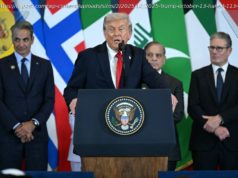With Brett Kavanaugh confirmed as Supreme Court Justice, it means that five of the nine Supreme Court justices are members of the Federalist Society, a network of right-wing conservative lawyers that has become one of the most powerful groups in America today. The most enduring legacy of the Trump administration may be its remaking of the…
So how did the Society, which began as a students’ group, become so powerful – and what does it stand for?
The organisation rapidly spread to campuses across the country, spurred by funding from wealthy conservative donors such as the Koch brothers, and later sprung professional chapters too. Today the Federalist Society has 70,000 members and a presence on almost every university campus and in every major city. It organises regular talks and events for law students and practicing lawyers, which provide an opportunity for conservative lawyers to network and build reputations.
As well as building links between conservative lawyers, the Federalist Society’s talks and events have provided a way for it to spread and develop its ideas and approach to judicial philosophy. The Society grew up with its first student members, as they began taking up senior jobs in government and the judiciary, providing the Federalist Society with a network of like-minded lawyers that extends right up to the Supreme Court and the President (the White House lawyer Don McGahn is a member of the Federalist Society) and across campuses, companies and local courts around the country.
As well as being well-organised and well-funded, the Federalist Society’s ideological purity makes it a formidable political force, Teles argues. Its members are united by their judicial philosophy rather than any partisan affiliation to the Republican Party.
On its website it describes these principles as “that the state exists to preserve freedom, that the separation of governmental powers is central to our Constitution, and that it is emphatically the province and duty of the judiciary to say what the law is, not what it should be”, which entails “reordering priorities within the legal system to place a premium on individual liberty, traditional values, and the rule of law”.
As this abstract wording suggests, the range of opinions held by members of the Federalist Society is quite broad though they share a similar approach to the law. The main tension within the group is between those who believe their primary function should be constraining the federal judiciary and those who believe their role is to empower the federal judiciary to enforce what they see as America’s founding principles, Teles says.
At the Trump administration’s request, Leo drew up a list of 25 potential Supreme Court nominees for the president’s consideration, which included Kavanaugh. At the same time, the influence exerted by the Senate on the nomination process has decreased.
“It used to be that Republican Senators played a much more important role in judicial selection than they do now, so ordinary party patronage mechanisms used to be more important. But I think this ideological network that we associated with the Federalist Society has clawed away more and more power from that senatorial role over time,” says Teles. “And it’s clearly the case that Trump… has been willing to completely subcontract this over to these conservative judicial networks.”
This may be, as Avery suggests, because Trump is “lazy” and by outsourcing his work to the Federalist Society he can be sure they will put forward people who appeal to the president’s conservative base. Or it may be, as Teles suggests, that Trump realises that such a transactional relationship is his best way of keeping social conservatives on his side.
One of the most effective checks on Trump has been the US courts, who have challenged some of the administration’s most egregious policies, from the Muslim ban, to child separations, the rescindment of DACA and environmental deregulation. In addition to the threat to women’s reproductive rights and LGBT rights, a judicial system dominated by right-wing libertarians might have responded very differently to Trump’s executive orders.
“It’s important for all Americans to understand that the extreme right wing, the extreme conservatives, are much better organised, much better financed, and have a much better idea of what they’re about than the liberals or progressives do. The liberals or progressives need to wake up and take a look at what’s happening at the other end of the ideological spectrum and figure out a way to get their own house in order, because liberals and progressives have been losing ground now for the last almost 40 years, and even to this day they have not come with either an effective set of ideas or an effective organising principle that allows them to make this a fair contest,” Avery tells me.
In the absence of an effective liberal alternative to the Federalist Society, the best hope for liberals is that they will win back control of Congress at the Midterms, he says.
“If the left-wing and progressives can’t capture the legislative branch and turn the popular will into their way of thinking, we’re in for a rough ride for the next several years if not decades.”
*
Note to readers: please click the share buttons above. Forward this article to your email lists. Crosspost on your blog site, internet forums. etc.
Comment on Global Research Articles on our Facebook page
Become a Member of Global Research






